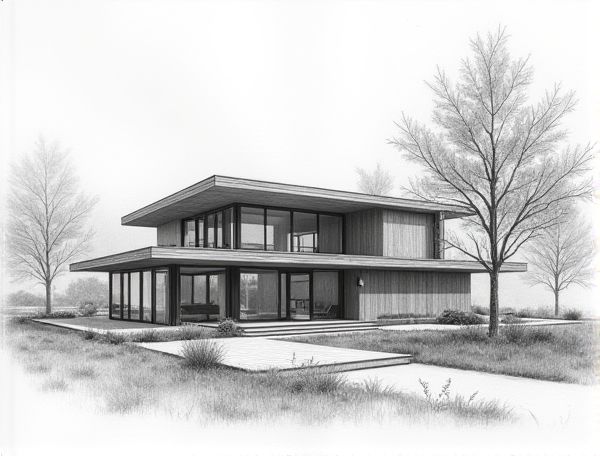
Photo illustration: Biophilic home design with passive solar heating
Biophilic home design integrates natural elements and passive solar heating to create energy-efficient, healthy living spaces that connect you with the outdoors while reducing your carbon footprint. Discover how incorporating these sustainable strategies can transform your home by reading more in the article.
Introduction to Biophilic Home Design
Biophilic home design integrates natural elements like sunlight, greenery, and organic materials to enhance your living space's connection to nature, promoting well-being and reducing stress. Incorporating biophilic principles can improve indoor air quality, increase comfort, and elevate the overall aesthetic of your home.
Principles of Passive Solar Heating
Passive solar heating relies on strategic window placement, thermal mass materials, and proper insulation to maximize solar energy absorption and minimize heat loss. Designing south-facing windows with overhangs and incorporating concrete or stone floors ensures efficient heat distribution and temperature regulation throughout the home.
Integrating Nature in Architectural Elements
Incorporating natural materials such as wood, stone, and bamboo creates a seamless blend between indoor spaces and the surrounding environment. Large windows and open floor plans maximize natural light and ventilation, enhancing the connection to outdoor greenery. Green walls, indoor gardens, and water features not only improve air quality but also introduce calming sensory elements that boost well-being.
Orientation and Layout for Optimal Sunlight
Positioning your home with south-facing windows maximizes natural sunlight throughout the day, enhancing energy efficiency and indoor comfort. Strategic room placement, such as locating living areas on the sunniest side and bedrooms in cooler, shaded areas, optimizes daily light exposure and temperature regulation. Your home's layout should incorporate open floor plans and minimal obstructions to allow sunlight to penetrate deeply and illuminate interior spaces effectively.
Material Choices for Natural Connection and Thermal Mass
Choosing materials like rammed earth, adobe, and stone enhances thermal mass, naturally regulating indoor temperatures by absorbing and slowly releasing heat. These sustainable options not only improve energy efficiency but also create a strong visual and tactile connection to the natural environment.
Window Design for Light and Heat Efficiency
Window design plays a critical role in maximizing natural light while minimizing heat loss and gain, enhancing overall energy efficiency in homes. Strategic placement of windows using double or triple glazing, low-emissivity (Low-E) glass, and thermal breaks reduces heat transfer and improves indoor comfort. Incorporating shading devices and optimizing window-to-wall ratios further balances daylight penetration with heat control.
Green Roofs and Living Walls for Thermal Benefits
Green roofs and living walls significantly enhance home energy efficiency by providing natural insulation that reduces heat absorption and loss. These eco-friendly features lower indoor temperatures during summer and retain warmth in winter, decreasing reliance on HVAC systems and cutting energy costs. Incorporating plants on roofs and walls also improves air quality while contributing to urban heat island mitigation.
Plant Selection for Indoor Microclimate
Choosing the right plants for your indoor microclimate significantly enhances air quality and humidity levels, promoting a healthier living environment. Consider species like snake plants, pothos, and peace lilies, which thrive in low light and varying humidity, adapting well to most indoor conditions. Proper plant selection minimizes maintenance while maximizing natural air purification, creating a balanced and comfortable home atmosphere tailored to your space.
Energy Savings and Environmental Impact
Energy-efficient home design significantly reduces your utility bills while minimizing environmental impact by lowering carbon emissions. Utilizing sustainable materials, solar panels, and smart insulation enhances energy savings and promotes eco-friendly living. Implementing these strategies supports a greener future and contributes to long-term cost efficiency in your household.
Tips for Implementing Biophilic and Passive Solar Features
Incorporate large, strategically placed windows to maximize natural sunlight and passive solar heating, reducing energy consumption in your home. Use natural materials like wood and stone to enhance the biophilic connection and create a calming indoor environment. Position plants near windows and integrate water features to improve air quality and promote well-being within your living space.
 homedesy.com
homedesy.com